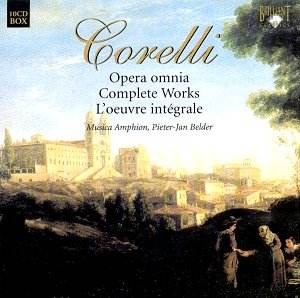Consolidated box sets
carry the advantage of a uniform musical
perspective when the performers remain
consistent. Such is the case here when
they’re drawn from the Dutch-based original
instrument ensemble Musica Amphion.
Founded and led by harpsichordist Pieter-Jan
Belder the players form part of that
constant pool of baroque instrument
talent to be found in Holland. The recording
project to set down Corelli’s instrumental
and concerted music occupied the group
over the summer of 2004 and the results
are here in ten well-filled discs housed
in a typical Brilliant box.
Naturally competition
is severe and the question is to what
extent the newcomers measure up. Their
main rivals in the earlier works will
be London Baroque and the Purcell Quartet
but older established admirers of the
Opp. 1 and 2 set will remember the English
Consort’s recordings with pleasure as
well. The older recordings presented
a more homogenous blend tonally speaking
and London Baroque take a more pliant
and expressive route to the Dutch ensemble.
The group derived from Musica Amphion
and led by Rémy Baudet is rather
more astringent and their rhythms aren’t
quite as engaged as are the other groups’.
In the second movement Allegro of Op.1
in F major for example the English Concert
were that much more buoyant. Take the
A major from the same set, No.3. The
organ is quite prominent in the newcomer’s
recording but whilst the tempo is more
static than in the English recordings
the cello line is boldly projected.
Entry points are explicitly delineated
in the first movement of Op.1 No.7 –
but turn back to the imaginative voicings
of the English Consort and you’ll hear
canny deployment of the theorbo; the
Dutch players opt to submerge colouristic
potential.
They don’t inflect
as much as their English contemporaries
and certainly not nearly as much as
the older English recording; they’re
straighter in Op.2 than the competition.
If you take Op.2 No.6 for example you’ll
find them, I think, rather faceless.
Of course in projects of this kind there’s
bound to be a degree of routine but
there are rather too many moments of
this kind hereabouts. Their phrasal
bluntness does become a matter of routine
as well and the sense of direct speaking
militates against sensitive exploration
of colour and tone. The same kind of
relationship exists when it comes to
the Op.5 Violin Sonatas between Baudet,
ter Linden, Fentross and Belder from
Musica Amphion and the Manze/Egarr team
on Harmonia Mundi or the Monica Huggett
led Sonnerie on Virgin. Manze goes in
for great dynamic gradients and a rich
panoply of expression; Huggett tends
to be more robust and has exercised
different editorial imperatives from
Manze, employing a continuo group as
does Musica Amphion. Manze and Egarr
stand alone and they’re consistently
the slowest performances of the three.
In the C minor, No.3, we find Huggett
et al have a far greater degree
of colour and articulation than Musica
Amphion and that their phraseology is
that much freer and more natural. It
doesn’t help that the Dutch recording
is quite chilly and tends towards over
brightness but I think that really only
amplifies or exacerbates the tonal qualities
of the band. Musica Amphion are clearly
closer to Sonnerie throughout; maybe
lighter in texture though considerably
more astringent, not least because Huggett
often cultivates an almost viola-like
depth of tone.
In short, when it comes
to Op.5 Musica Amphion lacks those qualities
of graceful phrasing, care over nuance,
clarity of trills and tonal expression
that are exemplified by the two other
groups cited. Certainly some may argue
that Manze can be just a shade too perfumed
and ostentatiously expressive but his
ornaments are a delight (try the opening
of No.10 in F major where he is unsurpassed)
and the affecting intimacy he cultivates
is astounding. The Dutch band doesn’t
over-ornament but they do tend, as a
result, to sound rather penny plain
judged against such imaginative responses.
The Concerto Grossi,
with the full band, are more impressive
than the earlier sets. I actually much
prefer them to, say, the Philharmonia
Baroque Orchestra under Nicholas McGegan
whose dutiful tidiness is shown up by
these colourful Dutch traversals. The
Brandenburg Consort under Roy Goodman
are pretty much among the pack leaders
as are Europa Galante under Fabio Biondi
(Hyperion and Harmonia Mundi respectively)
and these Dutch performances don’t really
challenge that hegemony. But I very
much liked the real sense of vibrancy
they evoke in, for example, the Pastorale-largo
of the Eighth Concerto. And in the slow
movement of the Ninth and Tenth I sense
the kind and degree of colour and expression
that were lacking in the earlier sonatas;
it’s as if the ensemble can do what
the consort can’t, which is a pity.
The other, smaller
works are certainly competently done,
with the same cavils still applying.
To reprise; the recording quality is
chilly and somewhat abrasive, the performances
in the main part somewhat under-inflected
though thoroughly professional. The
price is ludicrously cheap but if it
was me I’d take London Baroque in the
earlier set, Manze in Op.5 (with a back-up;
his are sometimes idiosyncratic solutions)
and Goodman and Biondi in the Concerti
Grossi (they’re very different and both
are thoroughly recommendable). You won’t
go terribly wrong with this box – but
you will seldom feel any kind of frisson.
And in the end that’s what Corelli should
make you feel.
Jonathan Woolf







